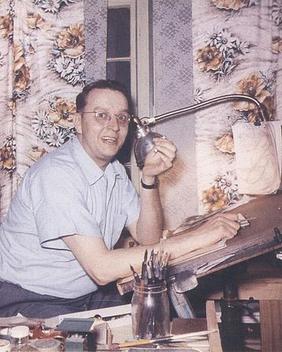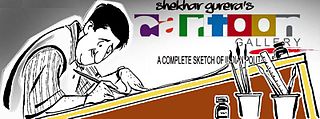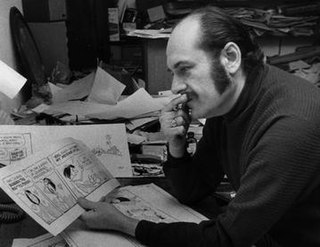
Tony Millionaire (born Scott Richardson [1] [2] in 1956) is an American cartoonist, illustrator and author known for his syndicated comic strip Maakies and the Sock Monkey series of comics and picture books.

Tony Millionaire (born Scott Richardson [1] [2] in 1956) is an American cartoonist, illustrator and author known for his syndicated comic strip Maakies and the Sock Monkey series of comics and picture books.
Millionaire grew up in and around the seaside town of Gloucester, Massachusetts. He came from a family of artists – his father was a commercial illustrator, his mother and grandparents were painters – and was encouraged to draw from an early age. His grandfather, who was a friend of the cartoonist Roy Crane, had a large collection of old Sunday comics, which were an early source of inspiration to Millionaire. He drew his first comic strip, "about an egg-shaped superhero who flew around talking about how great he was and then crashing into a cliff," [3] when he was nine years old. During high school, Millionaire continued to draw comic strips for his own amusement.
After high school, Millionaire attended the Massachusetts College of Art, where he majored in painting. While in college, he began drawing houses for money; this, along with occasional illustration jobs, would be his primary source of income for the next 20 years. After graduating from college, he moved from place to place, living in Boston; Florida; California; and Italy; before settling in Berlin for five years during the 1980s. Returning to the U.S. in the early '90s, he moved to Brooklyn, where he began drawing a regular comic strip, Medea's Weekend, for the Williamsburg newsweekly Waterfront Week.
One night at a local bar, the Six Twelve, Millionaire drew "a cartoon about a little bird who drank booze and blew his brains out" [4] on a napkin – the origin of his best-known character, Drinky Crow. The bartender encouraged him to draw more cartoons, offering him a free beer for each one he completed. After doing many of these cocktail napkin drawings, Millionaire began drawing more polished versions of his cartoons for publication in various zines, including Spike Vrusho's Murtaugh and Selwyn Harris's HappyLand. He also did drawings for several trade journals and Al Goldstein's notorious tabloid Screw . Eventually the alternative newsweekly New York Press asked him to draw a weekly strip, and in 1994, Maakies debuted in its pages. It soon spread to other papers across the country. During the mid-2000s, Millionaire transferred Maakies to The Village Voice as its NYC venue, but returned it to the New York Press in February 2007. [5]
Besides Maakies, Millionaire has produced a series of comics and picture books, collectively titled Sock Monkey . He has also occasionally contributed to comics anthologies including Legal Action Comics , Star Wars Tales , Marvel's Strange Tales , Dirty Stories, and Bizarro Comics. His illustrations are published in many leading venues including The New York Times , The New Yorker and The Wall Street Journal . Currently, he does much of the artwork, along with Charles Burns, for Dave Eggers' magazine The Believer . Animated versions of his work have been featured on Saturday Night Live , in the They Might Be Giants documentary Gigantic , and on Adult Swim . In 2006, Fantagraphics Books published his graphic novel Billy Hazelnuts. He is working on a children's book to be published by Hyperion. Since February 10, 2010, Millionaire's comic Maakies has been published weekly in Nib-Lit . [6]
Millionaire draws in a lush style that mingles naturalistic detail with strong doses of the fanciful and grotesque. His linework resembles that of Johnny Gruelle, whom he cites as one of his main sources of inspiration, along with Ernest Shepard and "all those freaks from the twenties and thirties who did the newspaper strips"; [7] many of Millionaire's admirers adduce a similarity to the work of E. C. Segar in particular. He draws with a fountain pen.
The nautical settings of much of Millionaire's work draw inspiration from his childhood memories of his grandparents' artwork and seaside home, as well as the novels of Patrick O'Brian, of which he is an avid reader.
When asked in interviews why he uses a pen name, Millionaire maintains that he does not, and that "Tony Millionaire" is his real name: "It is my legal name, and it's been around a lot longer than I've been a cartoonist." [8] He has said his unusual surname is an Old French word meaning "a person who owns a thousand serfs," [4] but the origin of the name "Tony Millionaire" is a character in an episode of the 1960s TV series I Dream of Jeannie . [1]
Millionaire has speculated that in the future he may publish some family-friendly works of his under a different moniker, in order to dissociate them from his other, more ribald output. [9] [10]
Millionaire's actual name is Scott Richardson.

A comic strip is a sequence of cartoons, arranged in interrelated panels to display brief humor or form a narrative, often serialized, with text in balloons and captions. Traditionally, throughout the 20th and into the 21st century, these have been published in newspapers and magazines, with daily horizontal strips printed in black-and-white in newspapers, while Sunday papers offered longer sequences in special color comics sections. With the advent of the internet, online comic strips began to appear as webcomics.

A cartoon is a type of visual art that is typically drawn, frequently animated, in an unrealistic or semi-realistic style. The specific meaning has evolved, but the modern usage usually refers to either: an image or series of images intended for satire, caricature, or humor; or a motion picture that relies on a sequence of illustrations for its animation. Someone who creates cartoons in the first sense is called a cartoonist, and in the second sense they are usually called an animator.

Sergio Aragonés Domenech is a Spanish/Mexican cartoonist and writer best known for his contributions to Mad magazine and creating the comic book Groo the Wanderer.

Jack Ralph Cole was an American cartoonist best known for creating the comedic superhero Plastic Man, and his cartoons for Playboy magazine.

The Far Side is a single-panel comic created by Gary Larson and syndicated by Chronicle Features and then Universal Press Syndicate, which ran from December 31, 1979, to January 1, 1995. Its surrealistic humor is often based on uncomfortable social situations, improbable events, an anthropomorphic view of the world, logical fallacies, impending bizarre disasters, references to proverbs, or the search for meaning in life. Larson's frequent use of animals and nature in the comic is popularly attributed to his background in biology. The Far Side was ultimately carried by more than 1,900 daily newspapers, translated into 17 languages, and collected into calendars, greeting cards, and 23 compilation books, and reruns are still carried in many newspapers. After a 25-year hiatus, in July 2020 Larson began drawing new Far Side strips offered through the comic's official website.

An editorial cartoonist, also known as a political cartoonist, is an artist who draws editorial cartoons that contain some level of political or social commentary. Their cartoons are used to convey and question an aspect of daily news or current affairs in a national or international context. Political cartoonists generally adopt a caricaturist style of drawing, to capture the likeness of a politician or subject. They may also employ humor or satire to ridicule an individual or group, emphasize their point of view or comment on a particular event.

James Kochalka is an American comic book artist, writer, animator, and rock musician. His comics are noted for their blending of the real and the surreal. Largely autobiographical, Kochalka's cartoon expression of the world around him includes such real-life characters as his wife, children, cat, friends and colleagues, but always filtered through his own observations and flights of whimsy. In March 2011 he was declared the cartoonist laureate of Vermont, serving a term of three years.
Maakies is a comic strip by Tony Millionaire. It began publication in February 1994 in the New York Press. It has previously run in many American alternative newsweeklies including The Stranger, LA Weekly and Only. It has also appeared in several international venues including the Italian comics magazine Linus and the Swedish comics magazine Rocky.

Howard Cruse was an American alternative cartoonist known for the exploration of gay themes in his comics. First coming to attention in the 1970s, during the underground comix movement with Barefootz, he was the founding editor of Gay Comix in 1980, created the gay-themed strip Wendel during the 1980s, and reached a more mainstream audience in 1995 when an imprint of DC Comics published his graphic novel Stuck Rubber Baby.

Dana Claire Simpson is an American cartoonist, best known as the creator of the comic Phoebe and her Unicorn, as well as the long-running webcomic Ozy and Millie. Other works created by Simpson include the political commentary cartoon I Drew This and the alternate reality drama comic Raine Dog.
Sam Henderson is an American cartoonist, writer, and expert on American comedy history. He is best known for his ongoing comic book series Magic Whistle. He was a contributor to the animated television series SpongeBob SquarePants and Camp Lazlo. Henderson has contributed work to Duplex Planet Illustrated, Zero Zero, 9-11: Artists Respond, Volume One, Mega-Pyton, Maakies, Nib-Lit, Legal Action Comics, and the animated shorts compilation God Hates Cartoons. He has also been a past participant in Robert Sikoryak's Carousel multimedia slideshow series.
Jimmy Johnson is an American comic strip cartoonist who writes and draws Arlo and Janis.
Tom Paterson is a Scottish comic artist who drew characters for Fleetway in 1973–1990, and D.C Thomson from 1986 to 2012. As of 2013, he currently draws strips for Viz. He lives in Leith, with three children, and is a Hearts supporter.

Irwin Hasen was an American cartoonist best known as the creator of the Dondi comic strip. He also had a significant run on DC Comics' original Green Lantern, Alan Scott, in the 1940s as well as creating Wildcat for the same publisher.

Sock Monkey is a series of comics and illustrated books written and drawn by the American cartoonist Tony Millionaire.

Howard Post was an American animator, cartoonist, and comic strip and comic book writer-artist.

The Drinky Crow Show is an American adult computer-animated cel-shaded animated television series created by Eric Kaplan and Tony Millionaire, based on the latter's comic strip Maakies. The pilot episode aired on Adult Swim on May 13, 2007. The series premiered on November 23, 2008 and ended its run on January 25, 2009. The cancellation of the show was confirmed by a Maakies comic.
Fred Curatolo is a freelance editorial cartoonist.
Nib-Lit is a weekly comics journal edited by Mykl Sivak and published both independently in an electronic format as well as running as a two-page section in Southern News, the student newspaper of Southern Connecticut State University. The journal features original and syndicated strips by a wide range of international cartoonists, both established and up-and-coming. It features a number of comics formats from single panel comic strips, to multi-page graphic short stories, to serialized graphic novels. The journal also prints comics related columns and criticism by writers from within and outside of the comics world. Nib-Lit also regularly releases a podcast featuring interviews with creators from across the comics world.
Comics journalism is a form of journalism that covers news or nonfiction events using the framework of comics, a combination of words and drawn images. Typically, sources are actual people featured in each story, and word balloons are actual quotes. The term "comics journalism" was coined by one of its most notable practitioners, Joe Sacco. Other terms for the practice include "graphic journalism," "comic strip journalism", "cartoon journalism", "cartoon reporting", "comics reportage", "journalistic comics", and "sketchbook reports".